Drosera eneabba N.G.Marchant & Lowrie
The epithet eneabba is an indigenous Australian name for the nearby springs, ena meaning water, and abba meaning small, thus “small springs”. This species was first discovered near the town of Eneabba.
Drosera eneabba is known from Western Australia, principally Eneabba, Badgingarra, Coomallo and Mount Lesueur.
It grows in white silica sand soils in low, open heath.
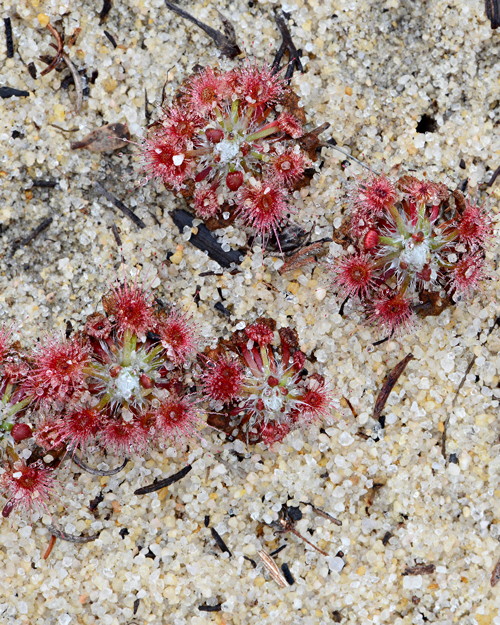
Drosera eneabba. Photo © Richard Nunn.
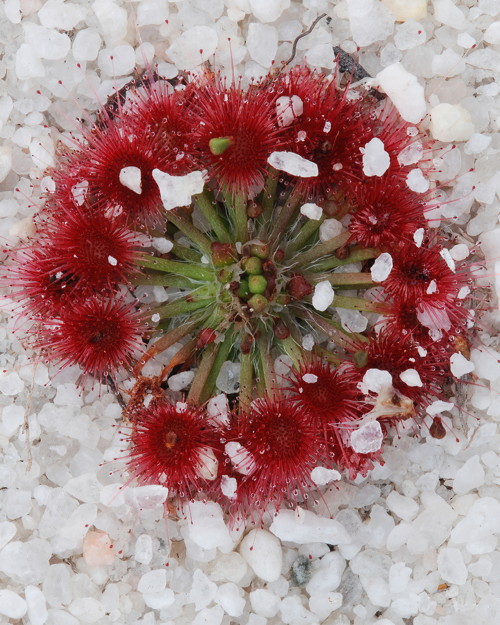
Drosera eneabba. Photo © Richard Nunn.
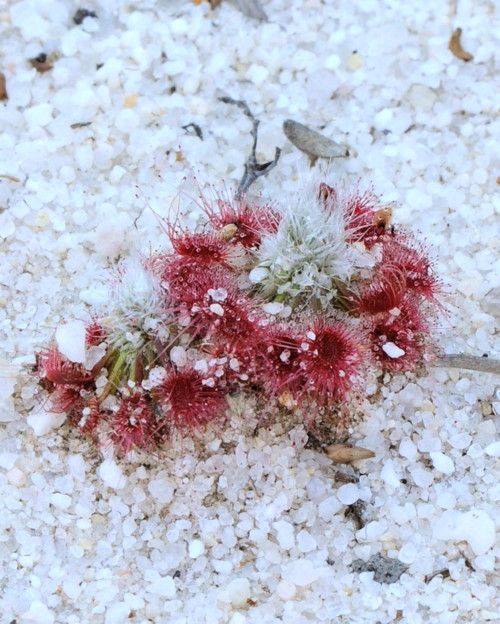
Drosera eneabba. Photo © Richard Nunn.
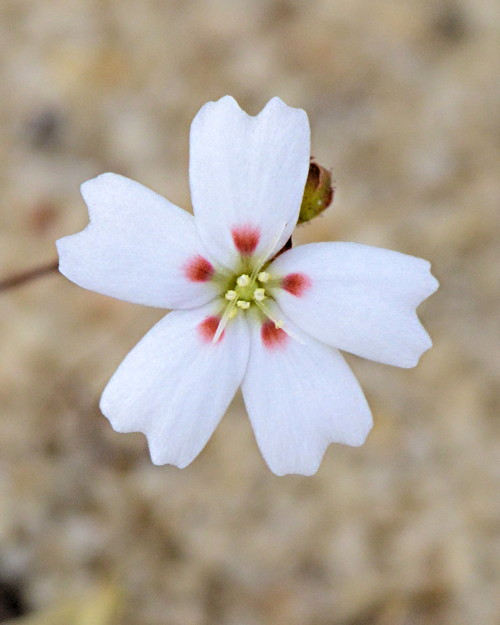
Drosera eneabba. Photo © Richard Nunn.
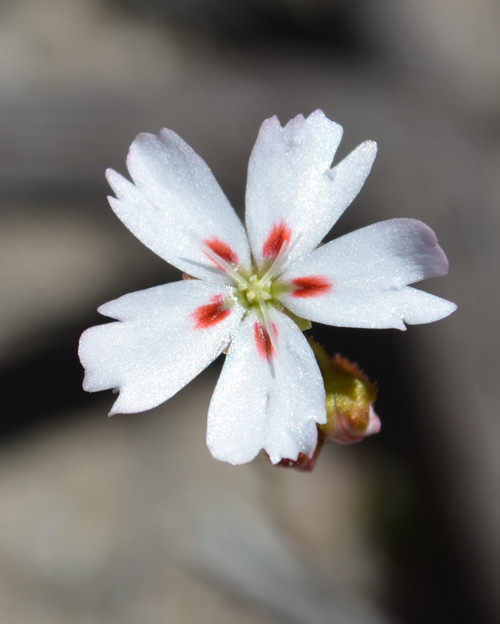
Drosera eneabba. Photo © Thilo Krueger.
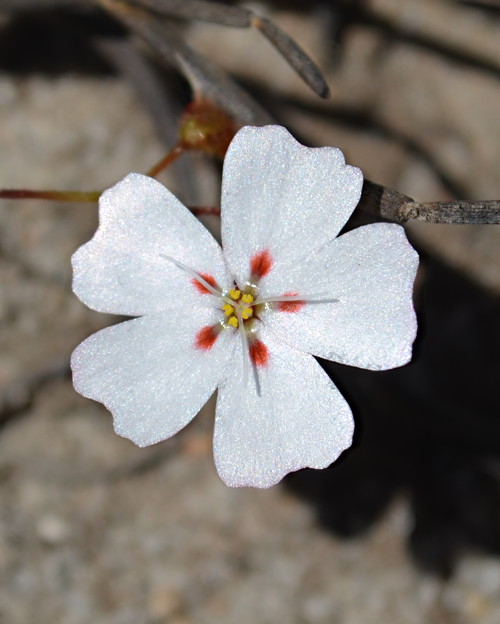
Drosera eneabba. Photo © Thilo Krueger.
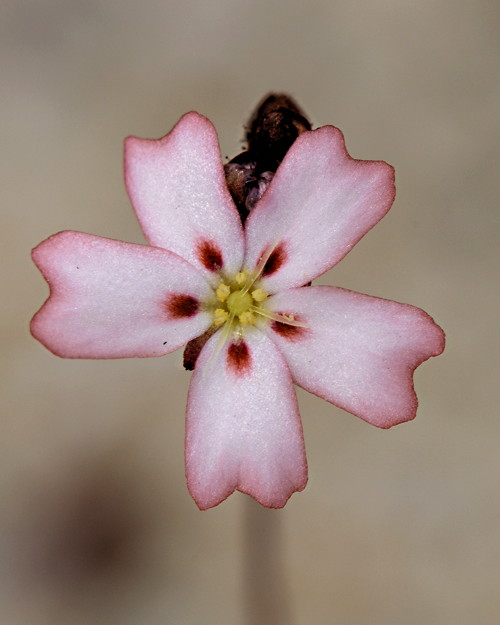
Drosera eneabba. Photo © Richard Nunn.
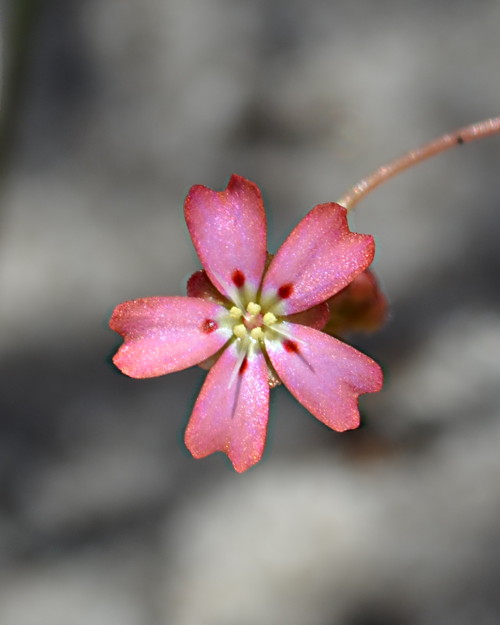
Drosera eneabba. Photo © Thilo Krueger.
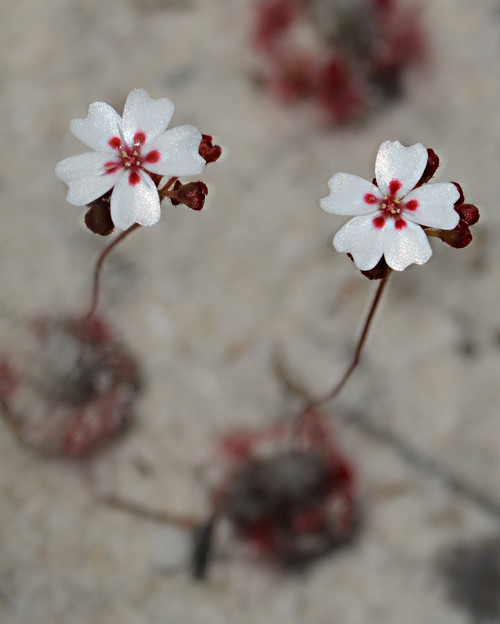
Drosera eneabba. Photo © Thilo Krueger.
Drosera enodes N.G.Marchant & Lowrie
The epithet enodes is derived from the Greek word meaning perfumed, in reference to the sweetly scented flowers of this species.
Drosera enodes is known from the extreme southwestern corner of Western Australia, with records from Scott River and Windy Harbour.
It grows in black peaty sand on the margins of swamps.
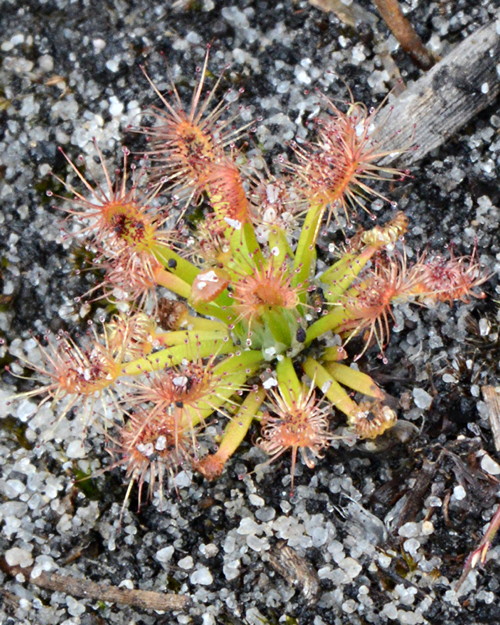
Drosera enodes. Photo © Richard Nunn.
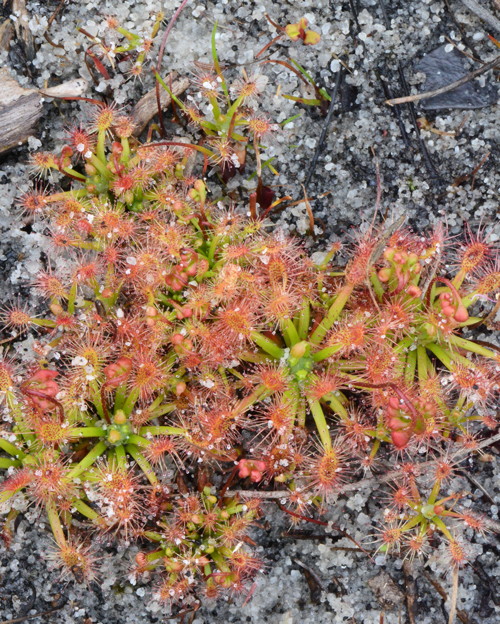
Drosera enodes. Photo © Richard Nunn.
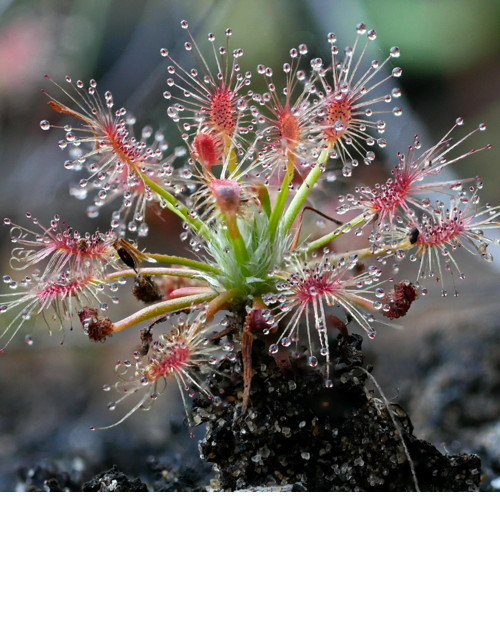
Drosera enodes. Photo © Thilo Krueger.
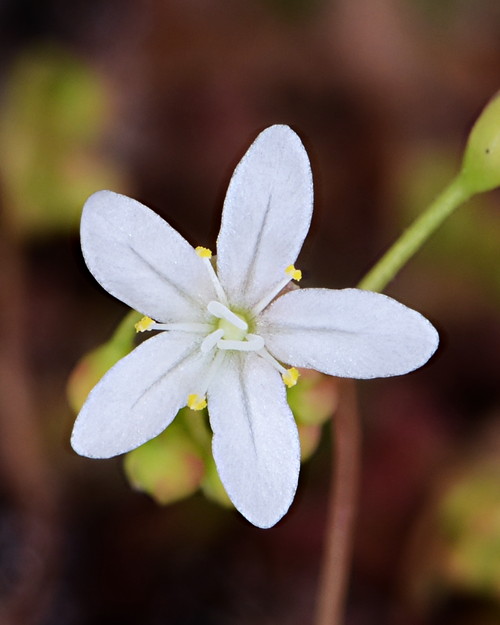
Drosera enodes. Photo © Richard Nunn.
Drosera gibsonii P.Mann
The epithet gibsonii honours Robert P. Gibson (1968–) of New South Wales, who has devoted many years to the study of carnivorous plants both in Australia and overseas.
Drosera gibsonii is known from Western Australia where it occurs near the base of Bluff Knoll and on Stirling Range Drive, ca. 13 kilometres to the west.
It grows on watershed slopes in clayey, sandy soils covered with an alluvium of small, flat, scattered sandstone rocks with Kingia australis, dwarf Eucalyptus species and smoke bush on low heath and scrub land.
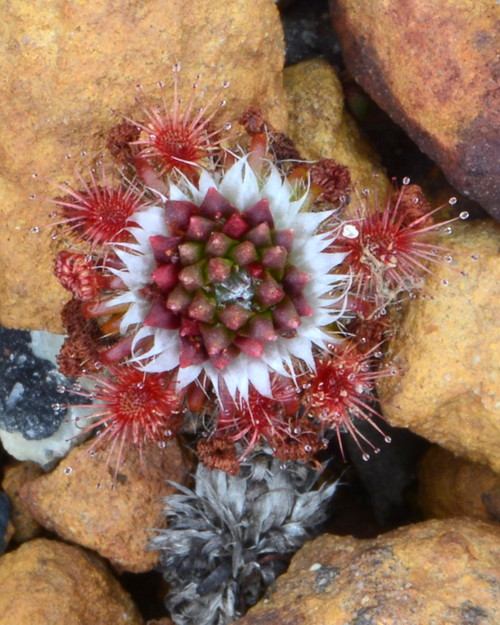
Drosera gibsonii. Photo © Richard Nunn.
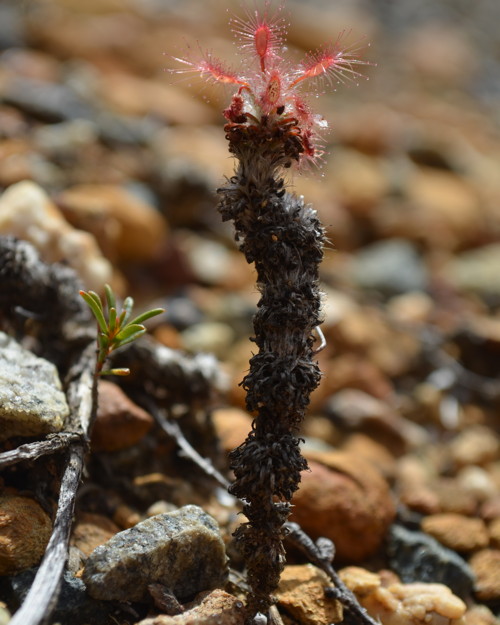
Drosera gibsonii. Photo © Thilo Krueger.
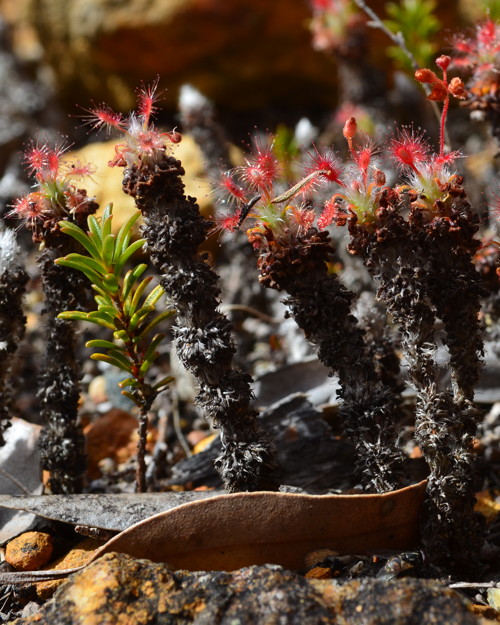
Drosera gibsonii. Photo © Thilo Krueger.
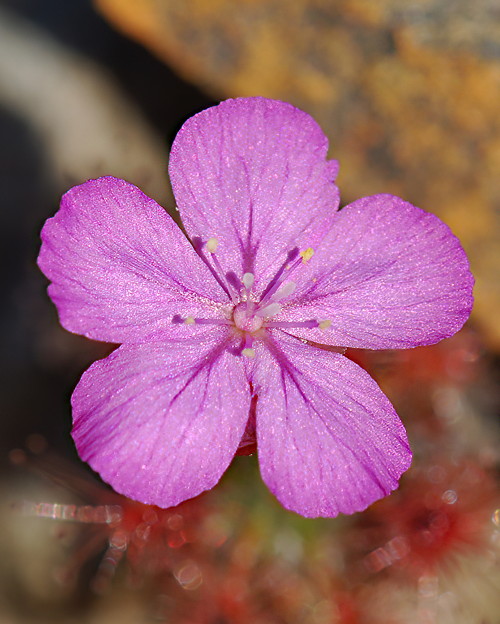
Drosera gibsonii. Photo © Richard Nunn.
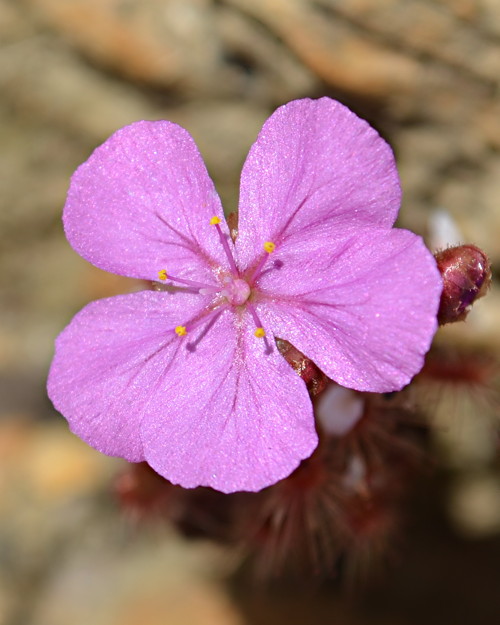
Drosera gibsonii. Photo © Thilo Krueger.
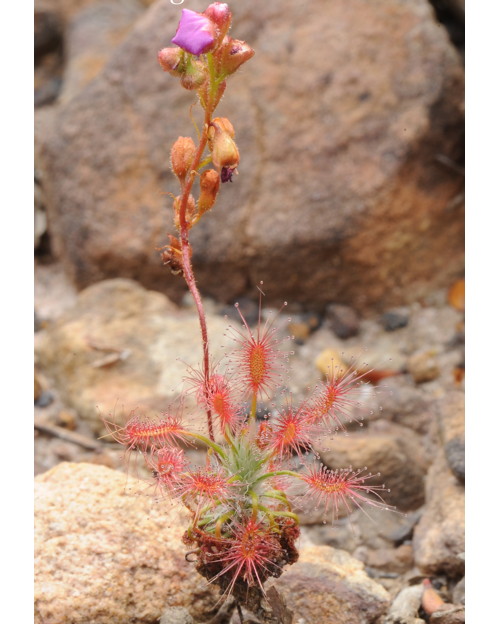
Drosera gibsonii. Photo © Richard Nunn.
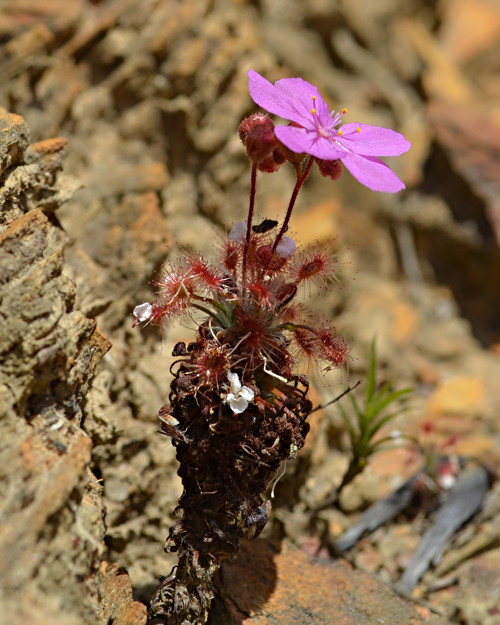
Drosera gibsonii. Photo © Thilo Krueger.
Drosera grievei Lowrie & N.G.Marchant
Drosera grievei is named in honour of Brian John Grieve (1907–1997), professor of botany, who provided the first comprehensive means of identifying the rich flora of southwest Western Australia. From 1954, Professor Grieve produced the outstanding series of books, “How to Know Western Australian Wildflowers”.
Drosera grievei is known from Western Australia, from the Lake Grace area east to Baanga Hill, and southeast to Fitzgerald from Lake King, and west of Lake King to Newdegate.
It grows in beige, sandy clay mixed with a little laterite in low, open heath.
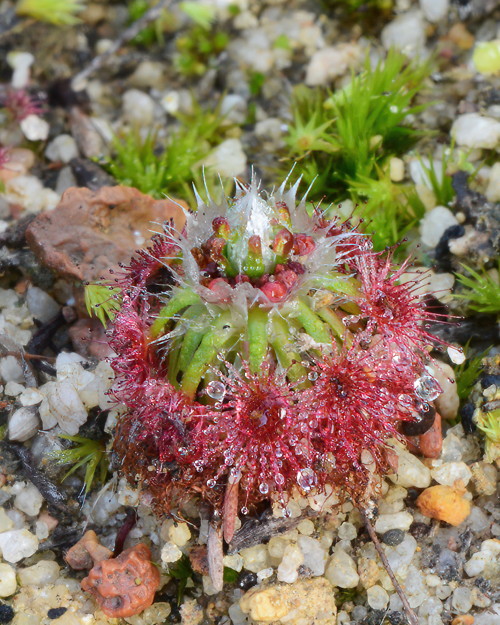
Drosera grievei. Photo © Richard Nunn.
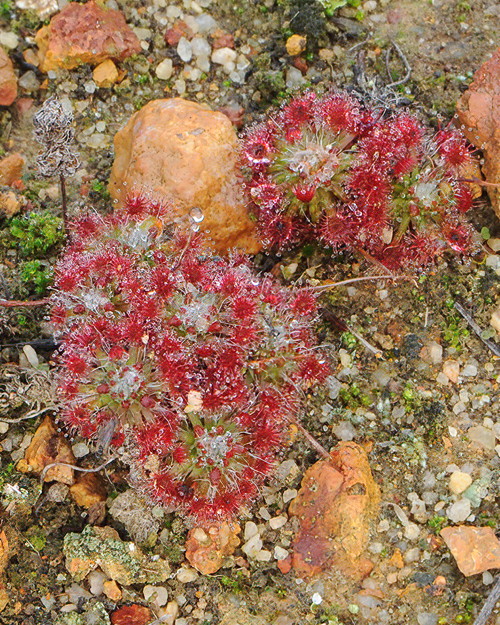
Drosera grievei. Photo © Richard Nunn.
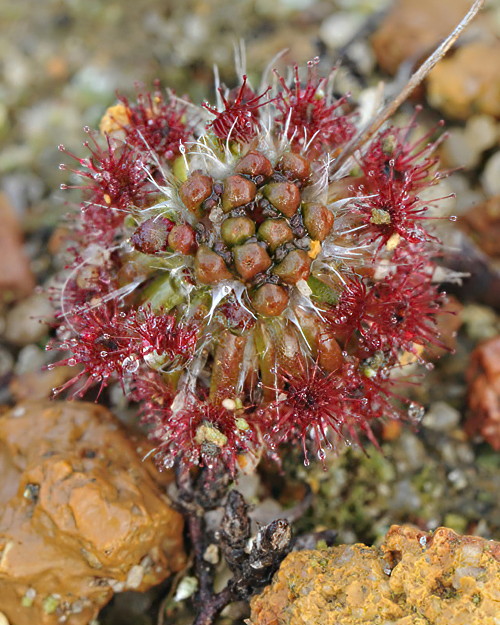
Drosera grievei. Photo © Richard Nunn.
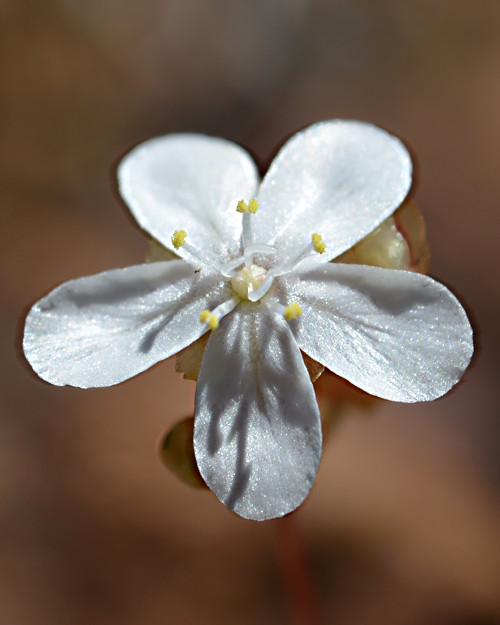
Drosera grievei. Photo © Thilo Krueger.
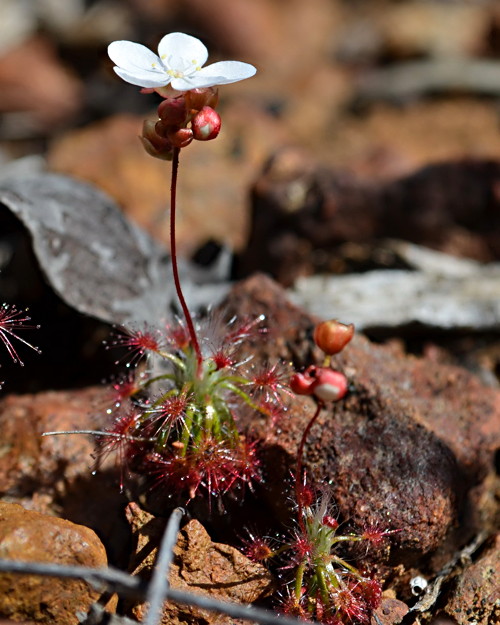
Drosera grievei. Photo © Thilo Krueger.
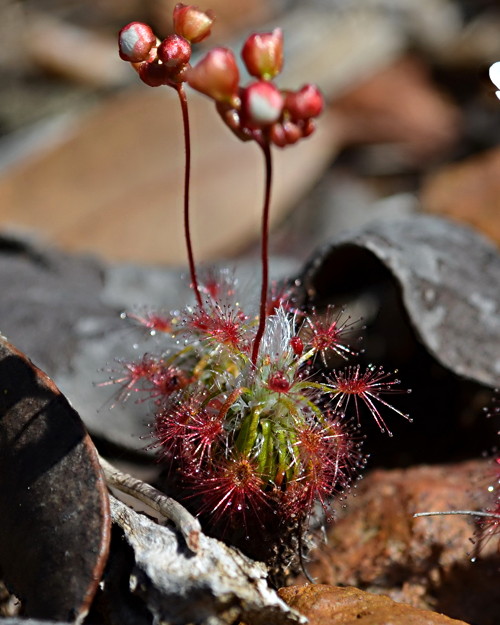
Drosera grievei. Photo © Thilo Krueger.
Drosera helodes N.G.Marchant & Lowrie
Drosera helodes is named from the Greek helodes (marsh), a reference to this species’ preference for seasonally wet, marshy habitats.
Drosera helodes is known from Western Australia, with records from Bullsbrook, Byford, Muchea and Gingin.
It grows in grey, white-grained sandy soils sometimes mixed with a little laterite in winter-wet depressions, as well as in black, but still white-grained, humic sandy soils on the margins of seasonal swampland systems.
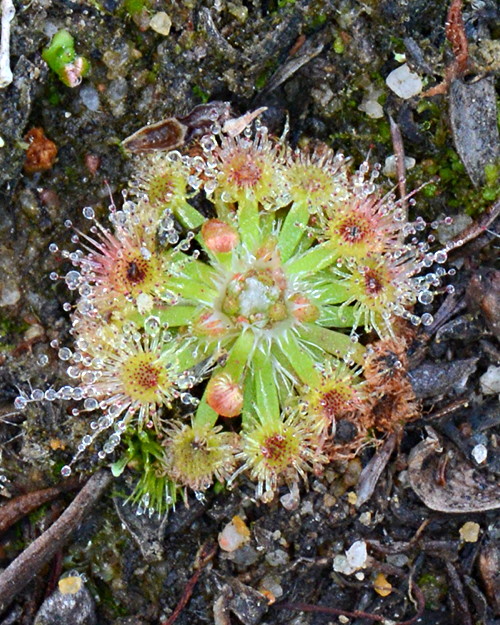
Drosera helodes. Photo © Richard Nunn.
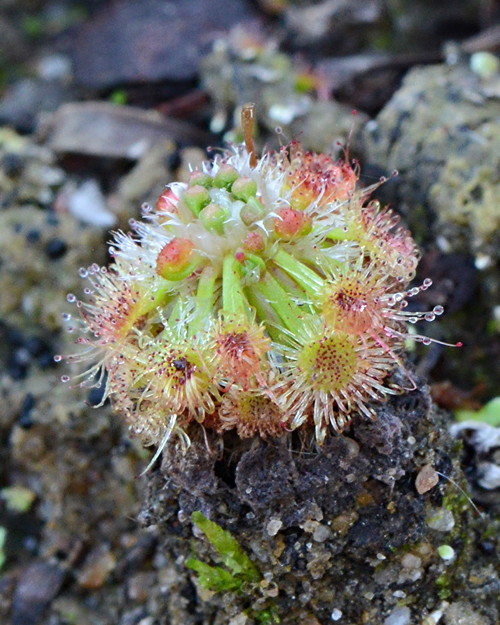
Drosera helodes. Photo © Richard Nunn.
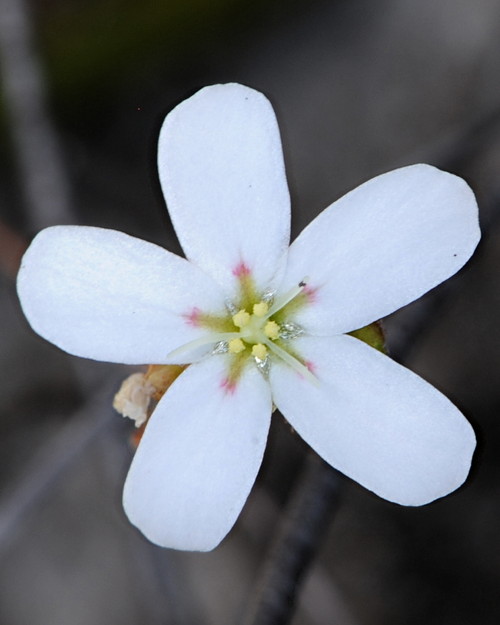
Drosera helodes. Photo © Richard Nunn.
Drosera hyperostigma N.G.Marchant & Lowrie
The epithet hyperostigma is derived from the Greek hyperon (club) and stigma (stigma), in reference to the obovoid stigma, which is attached at its base to the apex of the rod-like style.
Drosera hyperostigma is known from Western Australia, with records from Bannister, Bowelling, Gidgegannup, Lesmurdie, Marradong, Parkerville and The Lakes.
It grows in laterite mixed with silica sand soil in light, open forest.
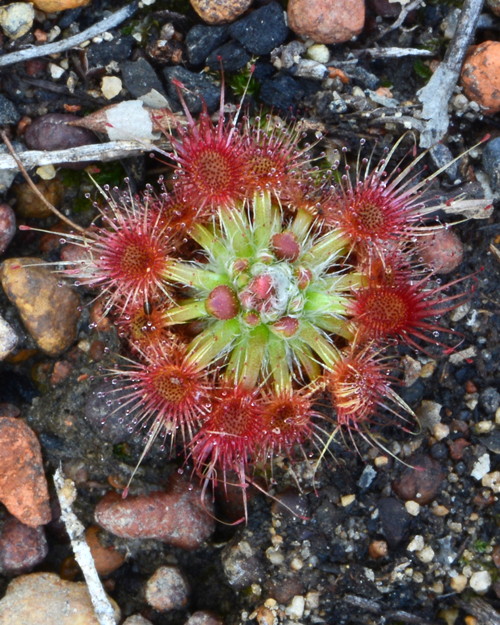
Drosera hyperostigma. Photo © Richard Nunn.
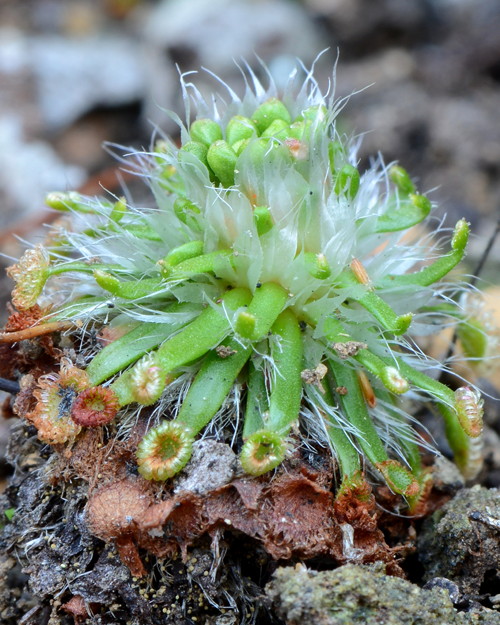
Drosera hyperostigma. Photo © Richard Nunn.
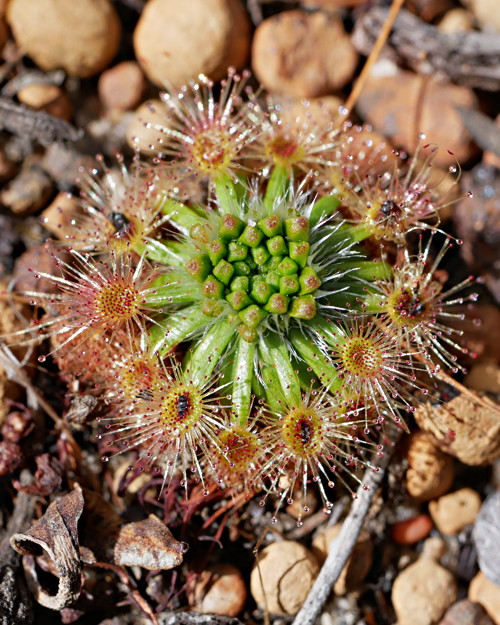
Drosera hyperostigma. Photo © Thilo Krueger.
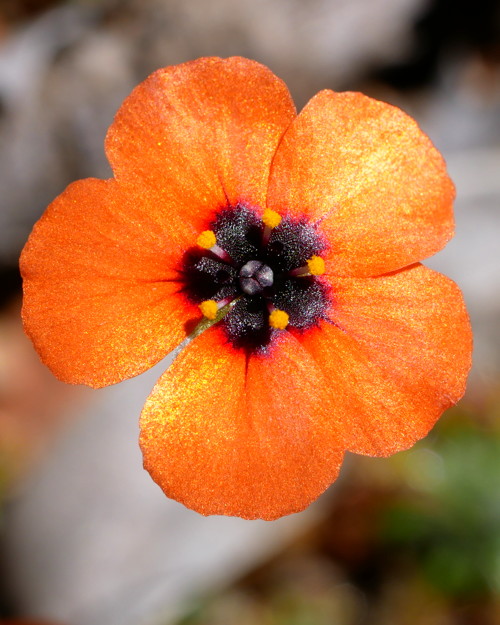
Drosera hyperostigma. Photo © Thilo Krueger.
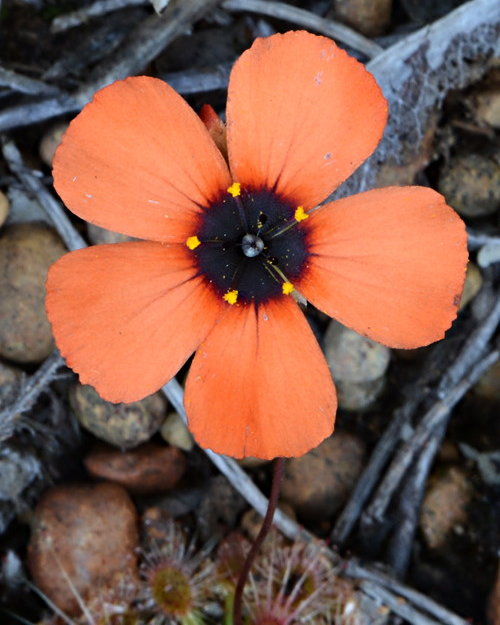
Drosera hyperostigma. Photo © Richard Nunn.
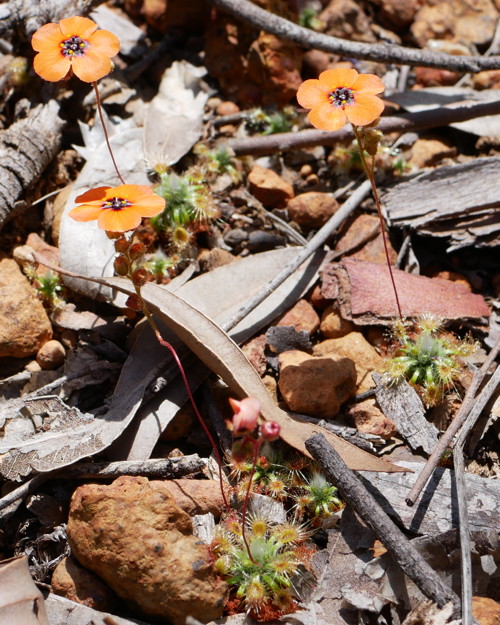
Drosera hyperostigma. Photo © Thilo Krueger.
Drosera lasiantha Lowrie & Carlquist
The epithet lasiantha is derived from the Greek lasios (shaggy, hairy) and anthos (flower), in reference to the white, curly, wool-like, non-glandular indumentum densely covering the inflorescence.
Drosera lasiantha is known from Western Australia, with records from the Porongurup Range north of Albany, as well as Mount Lindesay northwest of Denmark.
It grows in loam-laterite soils in open areas on the higher scree slopes in low jarrah forest.
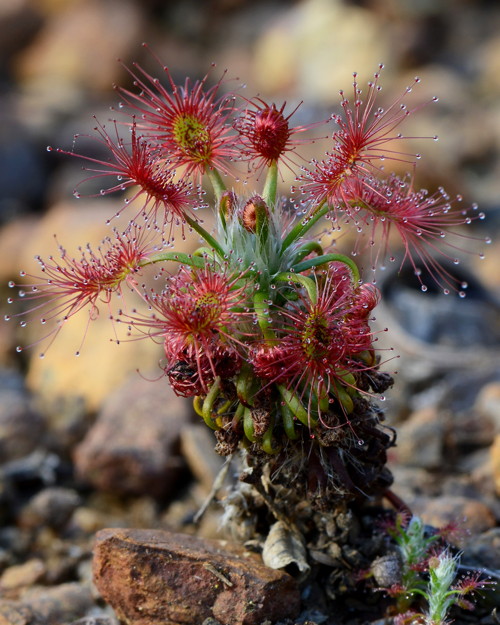
Drosera lasiantha. Photo © Richard Nunn.
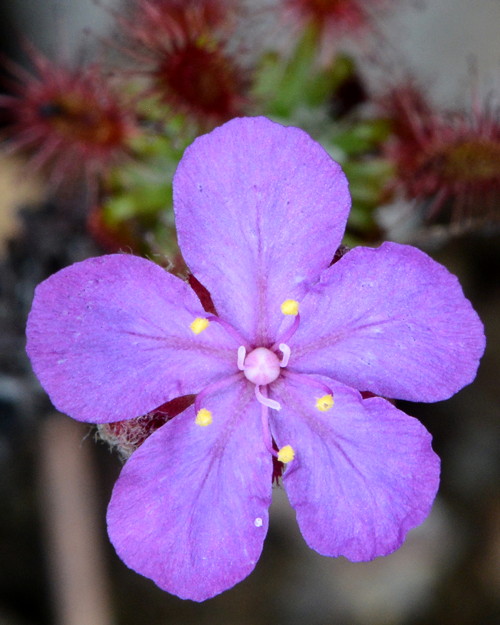
Drosera lasiantha. Photo © Richard Nunn.
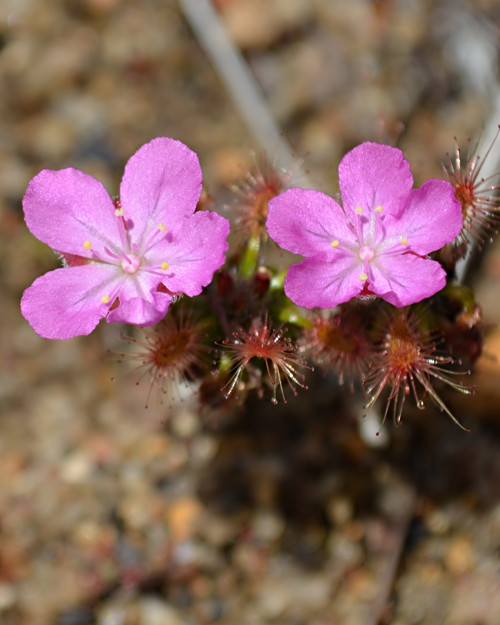
Drosera lasiantha. Photo © Thilo Krueger.
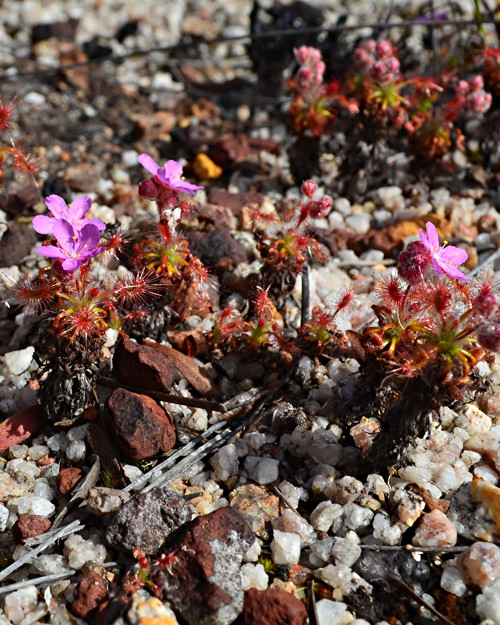
Drosera lasiantha. Photo © Thilo Krueger.
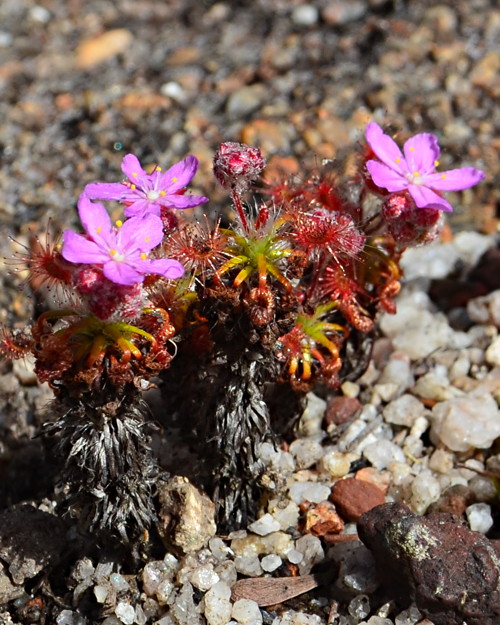
Drosera lasiantha. Photo © Thilo Krueger.
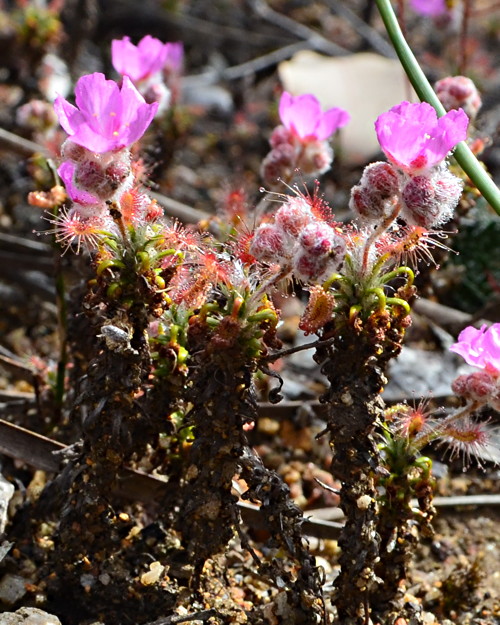
Drosera lasiantha. Photo © Thilo Krueger.
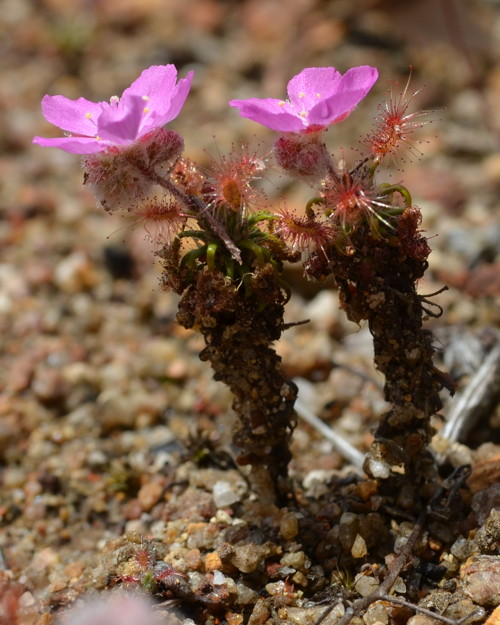
Drosera lasiantha. Photo © Thilo Krueger.
Drosera leioblastus N.G.Marchant & Lowrie
The epithet leioblastus is derived from the Greek leios (smooth to the touch) and blastos (shoot), in reference to the smooth stipular bud.
Drosera leioblastus is known from the Cataby region of Western Australia.
It grows in silica sand soils mixed with leaf litter humus and laterite pebbles under and between low heath.
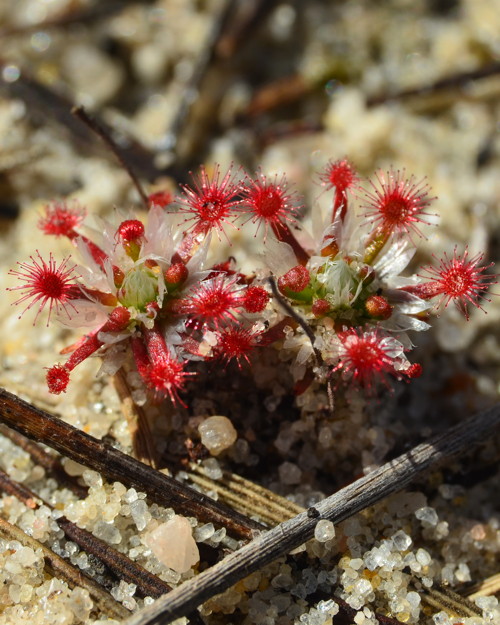
Drosera leioblastus. Photo © Thilo Krueger.
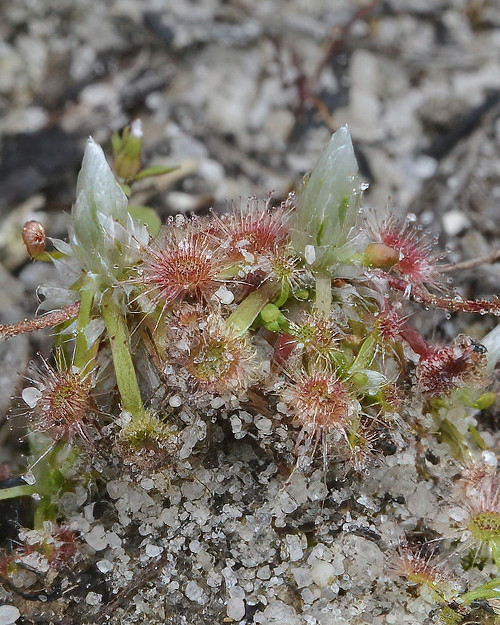
Drosera leioblastus. Photo © Richard Nunn.
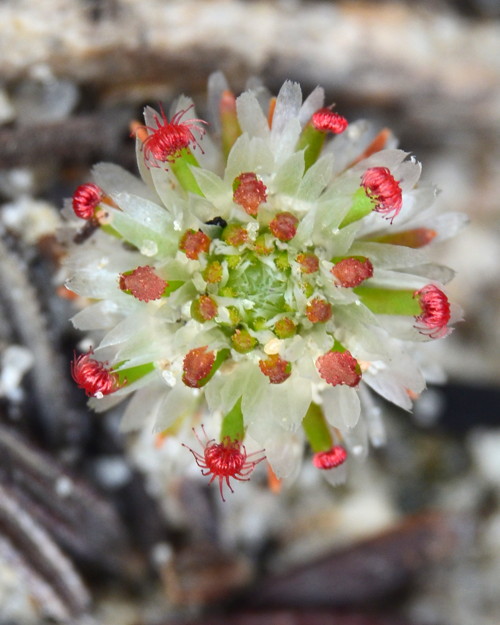
Drosera leioblastus. Photo © Thilo Krueger.
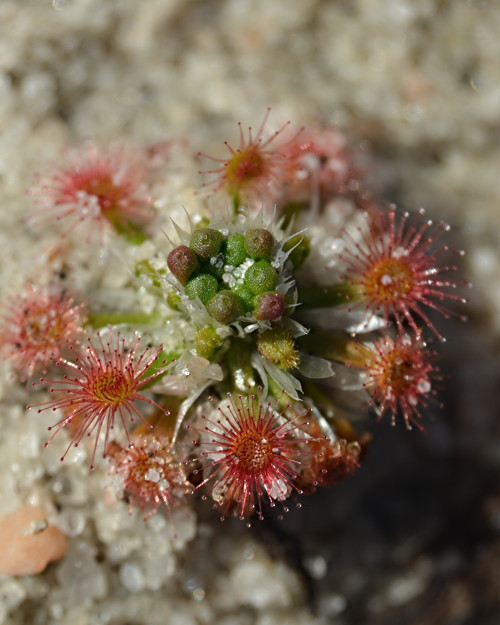
Drosera leioblastus. Photo © Thilo Krueger.

Drosera leioblastus. Photo © Richard Nunn.
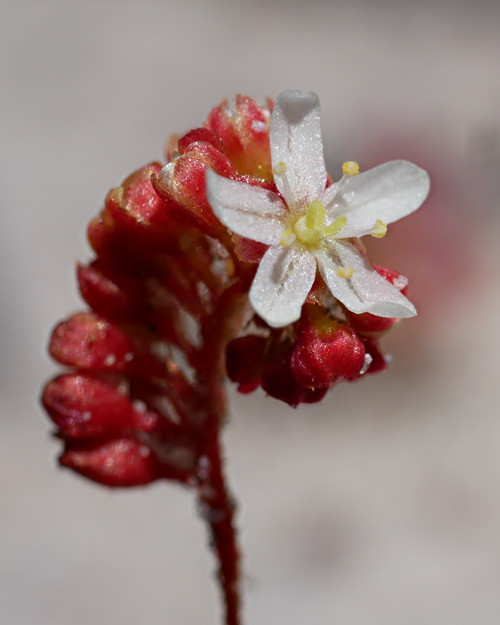
Drosera leioblastus. Photo © Thilo Krueger.
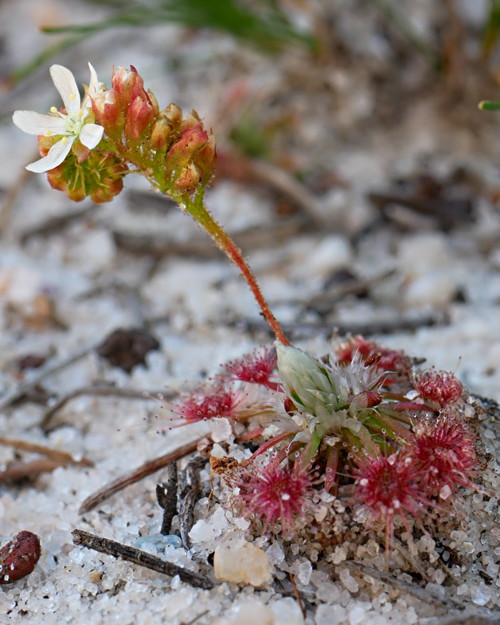
Drosera leioblastus. Photo © Thilo Krueger.
Drosera leucoblasta Benth.
The epithet leucoblasta is derived from the Greek leucos (white) and blastos (bud), in reference to the white stipular bud in the centre of the rosette of this species.
Drosera leucoblasta is known from Western Australia, with records from York, Brookton, Cranbrook, Arthur River and Esperance.
It grows in clayey sand and laterite soils between and under low shrubs in heathland regions.
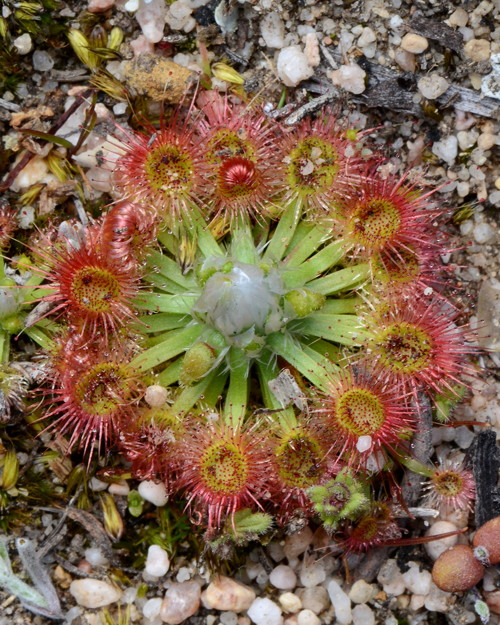
Drosera leucoblasta. Photo © Richard Nunn.
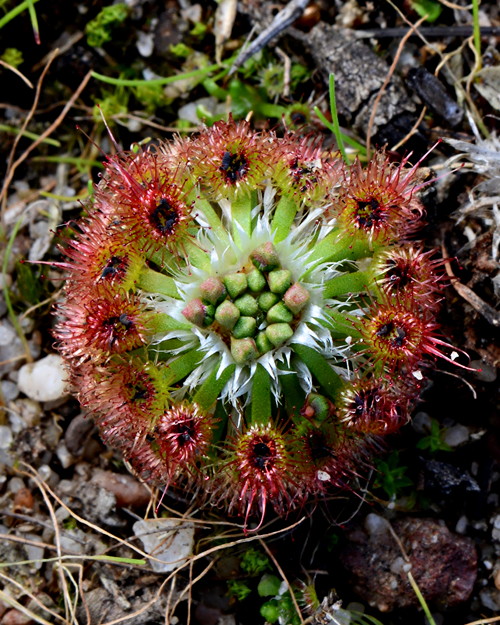
Drosera leucoblasta. Photo © Richard Nunn.
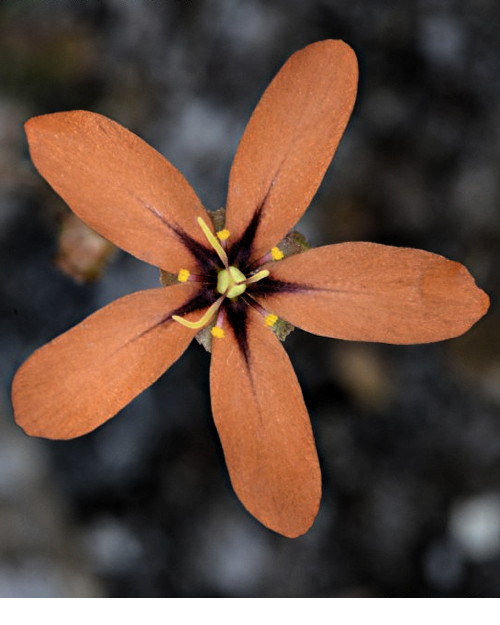
Drosera leucoblasta. Photo © Richard Nunn.
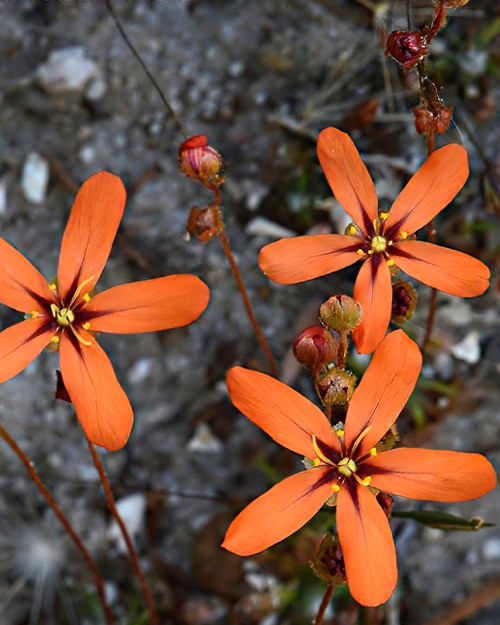
Drosera leucoblasta. Photo © Richard Nunn.
Drosera leucostigma (N.G.Marchant & Lowrie) Lowrie & Conran
The epithet leucostigma is derived from the Greek leucos (white) and stigma (stigma), in reference to the white colour of the reniform stigmas.
Drosera leucostigma is known from Western Australia, with records from the Cataby region, southeast to Mogumber.
It grows in sandy soils on the margins of winter-wet depressions.
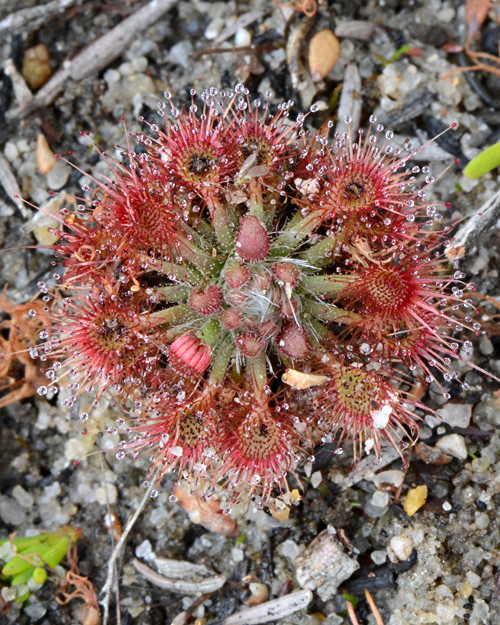
Drosera leucostigma. Photo © Richard Nunn.
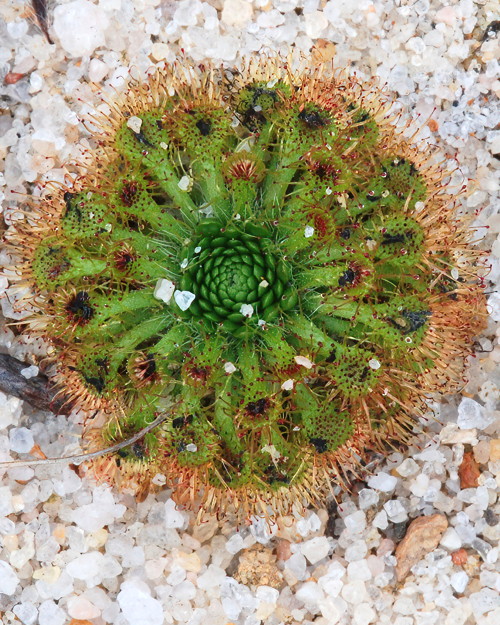
Drosera leucostigma. Photo © Richard Nunn.
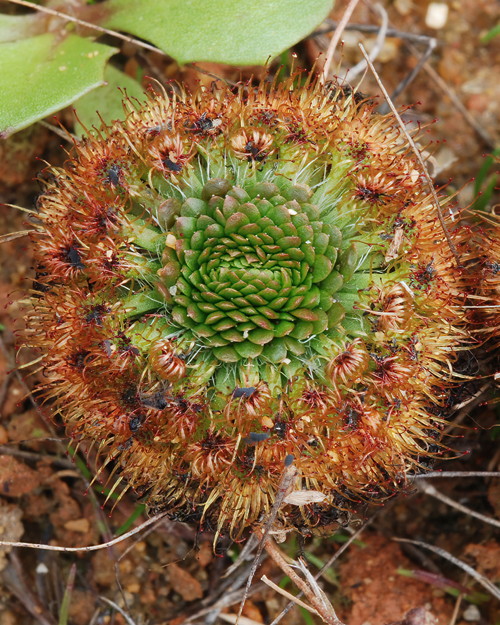
Drosera leucostigma. Photo © Richard Nunn.
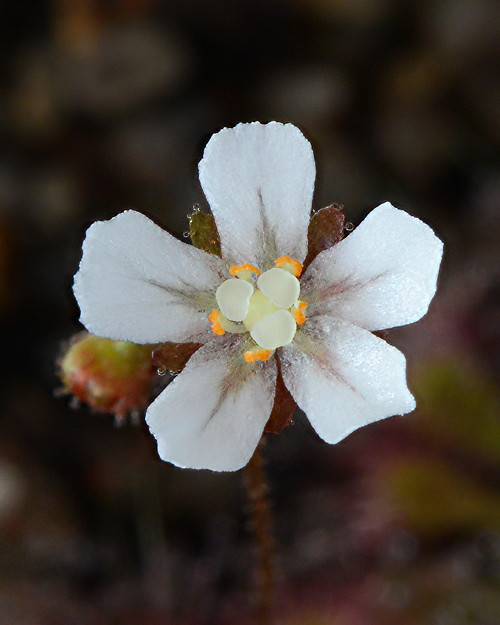
Drosera leucostigma. Photo © Richard Nunn.
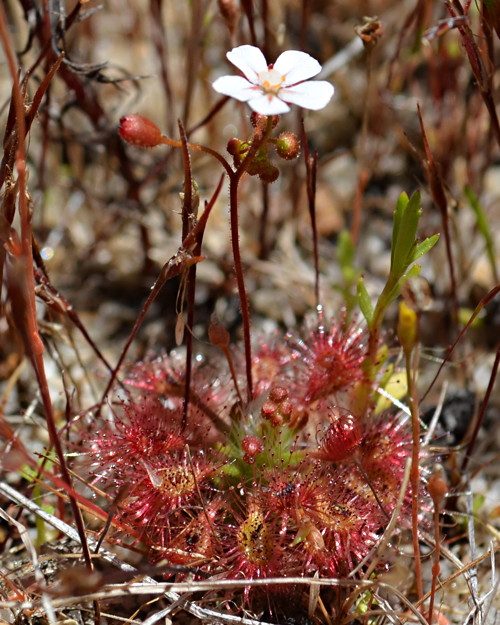
Drosera leucostigma. Photo © Thilo Krueger.
Drosera mannii Cheek
The epithet mannii honours Phill Mann (1951-2014), who first discovered this species growing alongside the Albany Highway.
Drosera mannii is known from Western Australia, with records from Gleneagle, Boulder Rock and towards Jarrahdale.
Drosera mannii grows at scattered locations in Jarrah forest on loam soils; peaty sand on winter-wet watersheds; and in loamy sand on the aprons of granite outcrops. At one location, it has been found growing in the peaty, skeletal soils held in the cracks and small hollows of a solid, lateritic rock pavement of a winter-wet creek.
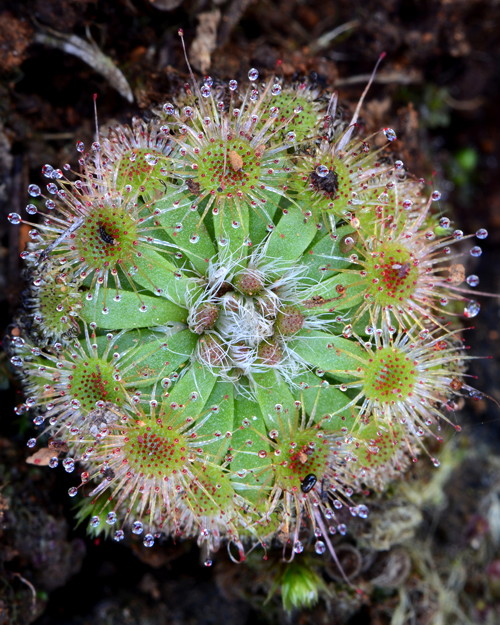
Drosera mannii. Photo © Richard Nunn.
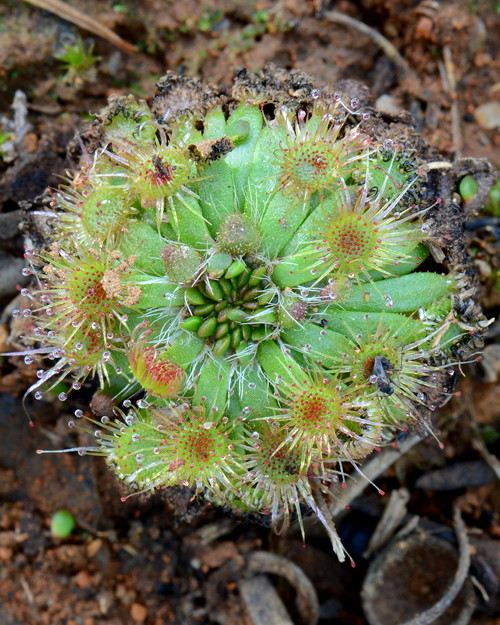
Drosera mannii. Photo © Richard Nunn.
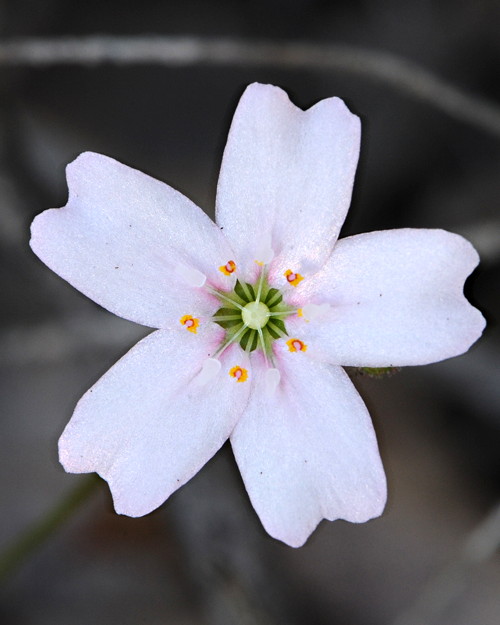
Drosera mannii. Photo © Richard Nunn.
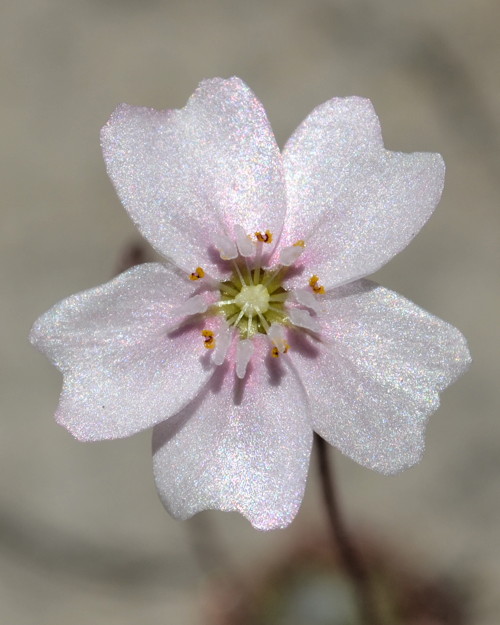
Drosera mannii. Photo © Thilo Krueger.
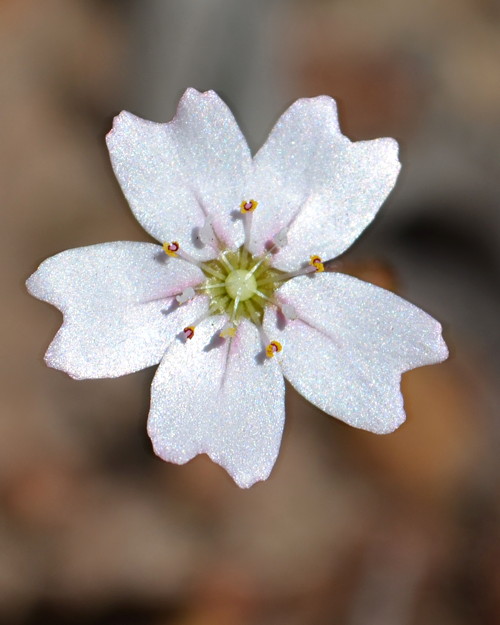
Drosera mannii. Photo © Thilo Krueger.
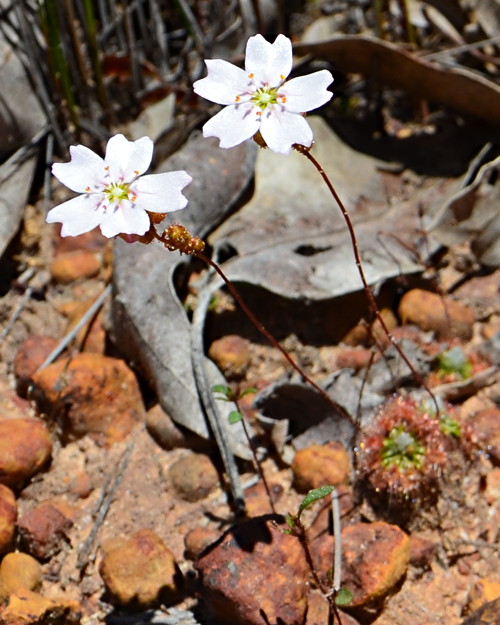
Drosera mannii. Photo © Thilo Krueger.
Drosera meristocaulis Maguire & Wurdack
The epithet meristocaulis is derived from the Greek meristos (divided, divisible) and caulos (stalk, stem), in reference to the frequently dividing stem of this species.
Drosera meristocaulis grows on Cerro de la Neblina at elevations of 1900–2200 m on the Venezuela/Brazil border.
It is mainly found in a region of knee-to waist-high heath-like savannah characterised by open slopes that alternate with major and minor valleys. The plants are found in semi-boggy conditions in small, rocky watercourses and in accumulated soil at the margins of sandstone outcrops.
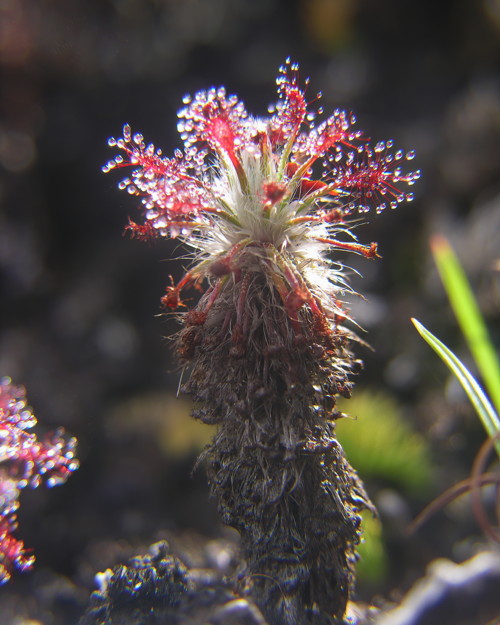
Drosera meristocaulis. Photo © Stewart McPherson.
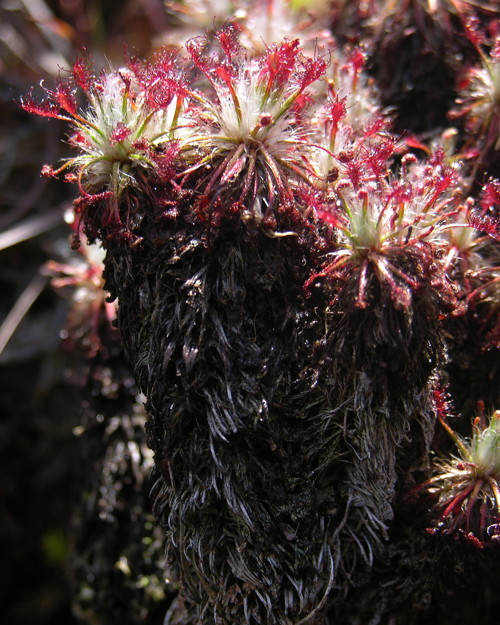
Drosera meristocaulis. Photo © Stewart McPherson.
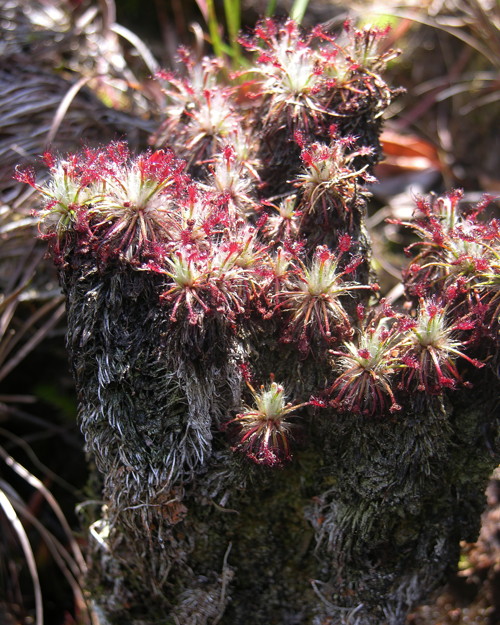
Drosera meristocaulis. Photo © Stewart McPherson.
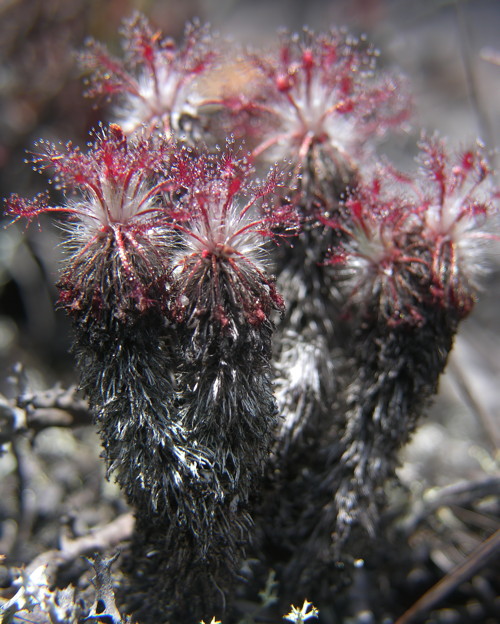
Drosera meristocaulis. Photo © Stewart McPherson.
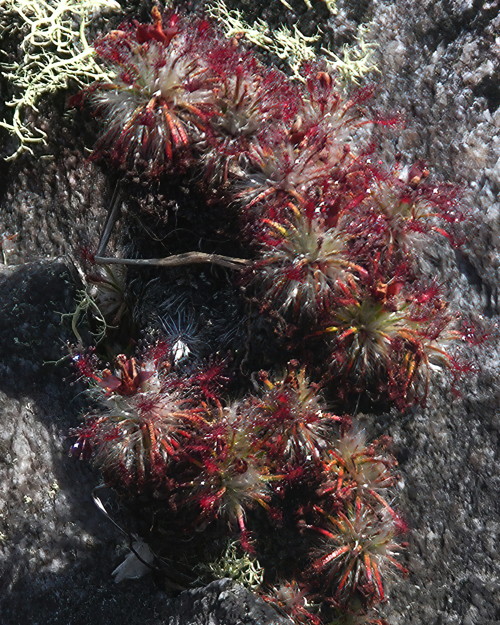
Drosera meristocaulis. Photo © Stewart McPherson.
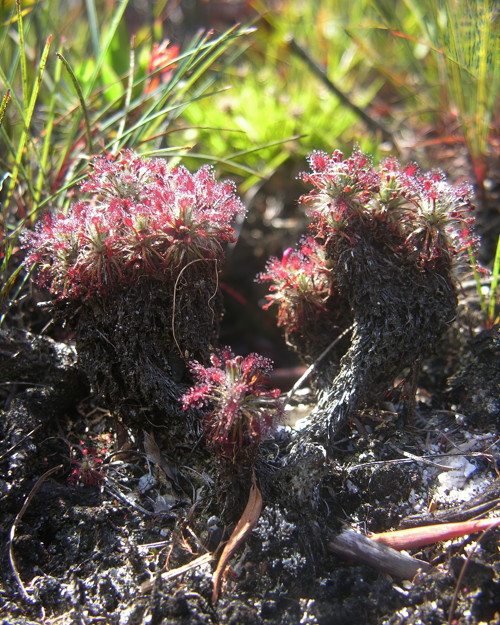
Drosera meristocaulis. Photo © Stewart McPherson.
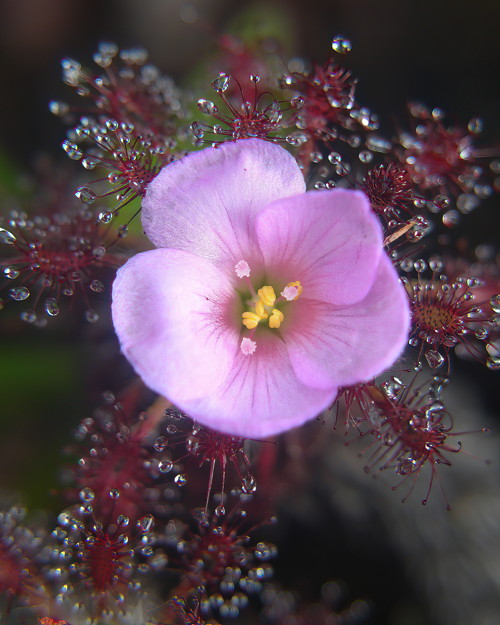
Drosera meristocaulis. Photo © Stewart McPherson.
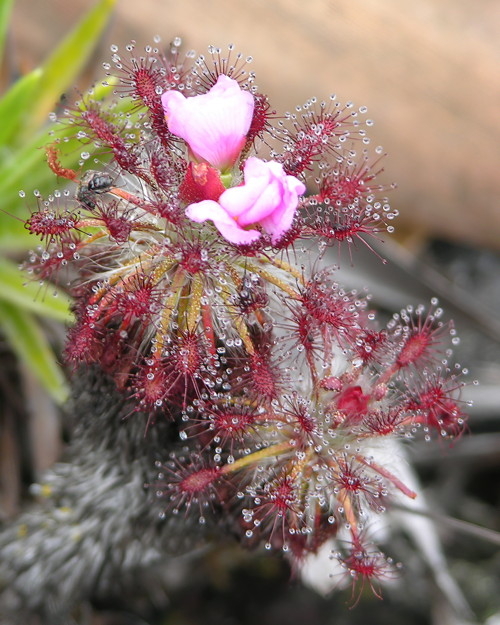
Drosera meristocaulis. Photo © Stewart McPherson.
